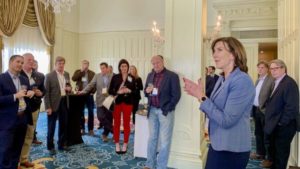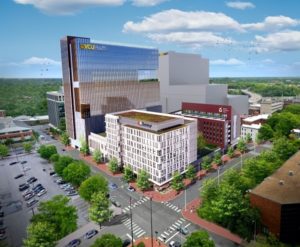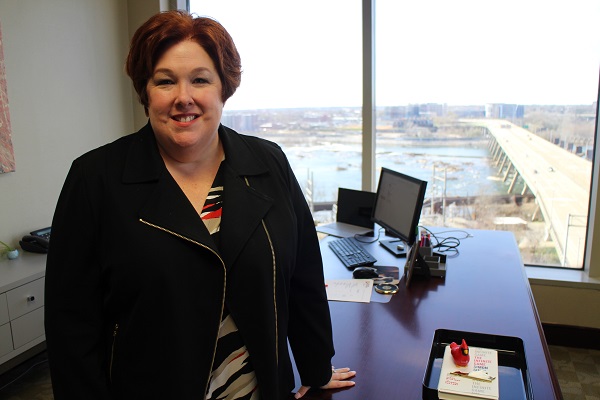Before the arrival of the coronavirus pandemic and the economic shutdown that came with it, Lara Fritts had spent many of her initial months on the job as CEO of Greater Richmond Partnership making the rounds, getting to know the area better while trying to get the word out about what she saw as the region’s top economic deterrent: a lack of available Class A office space.
Now, nearly a full year in and in the midst of the shutdown that’s just beginning phased reopenings, Fritts’ view about the need for more available space to attract and retain office users in the region hasn’t changed. That’s even as observers debate the demand for office space in a post-pandemic, work-from-home world.
Fritts is a Wisconsin native who was recruited from a similar job in Salt Lake City. She twice sat down with BizSense – at GRP’s office pre-shutdown, and more recently via video chat – to hammer home her message, why she feels that demand for office space will remain post-pandemic, and her first impressions of the region overall. The following is an edited transcript combining both interviews:
Richmond BizSense: Before the pandemic, you were advocating for development of more Class A office space, that a lack of it is deterring economic development. Your predecessor, Barry Matherly, had called for more shell building capacity. Why is this a priority for you?
Lara Fritts: One thing that I did when I first started, thanks to some urging from the staff, was conduct a qualitative survey of site selectors. (Something that) site selectors commented on was a lack of product. I thought, well, that can’t possibly be true; there seems to be a lot of activity happening.

GRP took part in a forum last year that brought more than 20 site selection consultants to the region. (GRP photo)
When we pulled the data, it is true: The majority of the new office buildings that have been built have been build-to-suit, and currently, there are only four office spaces over 40,000 square feet available now. There are buildings that are planned; they’re not available now.
What we’re finding is that companies are on much shorter timelines than they’ve ever been. They’re not looking three, four years in advance; we’re lucky if they’re thinking six months in advance. … The average square footage that they’re looking for, the median, is 85,000 square feet. So when we don’t have a lot of product, we’re automatically not even being included on the list.
For me, that’s concerning, because a site selector who’s putting 13 companies up against each other, if we’re automatically getting ruled out, that means they’re not even calling us, so we don’t even know about that project. It’s hard to win something you don’t even know about.
RBS: Do you think the pandemic has changed the demand for office space? Some observers are saying the work-from-home transition has revealed that companies don’t need as much space as they had.
LF: There are two schools of thought on what’s going to happen with commercial office space. The first is, people have found that the technology allows them to work from home more than we traditionally have done to date, and that may have companies considering reducing the footprint of their office space.
The other side of the spectrum is, because of Covid, are people going to go back to a traditional office environment, where you have offices and not big seas of cubicles where people are sitting one on top of another. I think if Covid has done anything, that separating of people may become a very important topic, and I think that you’ll see that concept of maybe increasing the footprint to separate people may actually come into play.

A recent development proposal from Capital City Partners would include 150,000 square feet of Class A office space, which the developer describes as spec and “designed to attract new business to downtown Richmond.
It’s also important to note that, when we look at our vacancy rates of over 150,000 square feet, we were essentially at full occupancy before Covid. Any shifting of office space is going to free up some, but it’s still not going to be enough for the amount of opportunity that I think is going to be out there post-Covid.
I think that companies that are in densely populated areas, like New York City, New Jersey, Boston, are going to be looking to expand their footprint, decentralize some of their staffing, and that really positions greater Richmond in a prime location to capture those opportunities, because we know that we are well-positioned for those middle office projects. But we need the office space in order to be able to recruit them.
RBS: So as far as you’re concerned, the priority for increasing and filling Class A office space in the Richmond region remains?
LF: I think it’s absolutely going to remain a priority for our region.
Just in the central business district, we’re at full occupancy. Full occupancy can be expected at about 6 percent vacancy (based on CoStar data), which is about where we are. The central business district is at 9.9 percent. When you look at vacancies as a whole region, where we do have vacancy is in very small spaces.
Total region vacancy of Class A is at 10.7 percent, which sounds high when you think about 6 percent being fully occupied. But if you think the majority of those spaces are less than 3,000 square feet, that’s pretty small, considering the average is about 250 square feet per employee. If you’re talking about 2,500 square feet, that’s 10 or less employees. It’s not a lot of space.
RBS: So what needs to be done? Is it as simple as just needing to build more buildings?
LF: That’s a component of it. You obviously want to be mindful that you don’t overbuild either, but when there is such a deficit of space in the entire region, it’s something we need to be having a conversation about.
We’ve made some suggestions to our local economic development partners. It’s really our local economic development partners who have the tools to work with the development community to bring new product online.
RBS: Is there a vacancy rate that Richmond needs to reach to be more competitive?
LF: It’s not so much about seeing a vacancy rate as it is having more product available.
Between doing the site development, drawing the drawings for the buildings, going out to market, marketing the building, trying to get a 50 percent pre-lease, and then actually constructing it, it’s about a three-year proposition. If companies aren’t thinking three years in advance, it becomes really difficult for them to pre-lease. They’re looking for immediate space, and that’s where we struggle.
We just don’t have anything available, and we don’t have developers looking at buildings speculatively. Why aren’t they building speculatively? The average rent for Class A office space is $26.50 a square foot. To build a new building today, just because of cost of construction, you’re looking at $35 to $40 a square foot. With a $9 square-foot gap, it makes it very difficult for someone to finance that construction.
The last piece to this puzzle is pre-leasing. Without companies that are thinking three years in advance who say, “Yes, we’d be willing to take X number of square feet in a new building,” that makes it really difficult to get a building financed as well.
RBS: Were there any economic development projects in the pipeline that have changed their plans in light of Covid?
LF: There’s really none that have changed their plans, but there’s definitely been a slowing of the pipeline. … In fact, we actually saw it slowing before Covid. That’s not to say that they won’t move forward; it’s just, everybody right now is focused on making sure that they are stabilizing their business before they talk about how they’re going to grow it.
Over the last couple of weeks, activity has really picked back up, so we’re bullish on the region and we’re looking forward to being able to share some exciting news soon.
RBS: Is that activity new inquiries, or are these projects that were put on hold that are starting back up?
LF: A little of both. We’re definitely seeing new activity, and we’re absolutely seeing projects that had been put on pause now reaching out, asking for more information. We had our first in-person site visit since the pandemic started that just took place a week ago, so that’s always a good sign when a company comes to visit.
Before the arrival of the coronavirus pandemic and the economic shutdown that came with it, Lara Fritts had spent many of her initial months on the job as CEO of Greater Richmond Partnership making the rounds, getting to know the area better while trying to get the word out about what she saw as the region’s top economic deterrent: a lack of available Class A office space.
Now, nearly a full year in and in the midst of the shutdown that’s just beginning phased reopenings, Fritts’ view about the need for more available space to attract and retain office users in the region hasn’t changed. That’s even as observers debate the demand for office space in a post-pandemic, work-from-home world.
Fritts is a Wisconsin native who was recruited from a similar job in Salt Lake City. She twice sat down with BizSense – at GRP’s office pre-shutdown, and more recently via video chat – to hammer home her message, why she feels that demand for office space will remain post-pandemic, and her first impressions of the region overall. The following is an edited transcript combining both interviews:
Richmond BizSense: Before the pandemic, you were advocating for development of more Class A office space, that a lack of it is deterring economic development. Your predecessor, Barry Matherly, had called for more shell building capacity. Why is this a priority for you?
Lara Fritts: One thing that I did when I first started, thanks to some urging from the staff, was conduct a qualitative survey of site selectors. (Something that) site selectors commented on was a lack of product. I thought, well, that can’t possibly be true; there seems to be a lot of activity happening.

GRP took part in a forum last year that brought more than 20 site selection consultants to the region. (GRP photo)
When we pulled the data, it is true: The majority of the new office buildings that have been built have been build-to-suit, and currently, there are only four office spaces over 40,000 square feet available now. There are buildings that are planned; they’re not available now.
What we’re finding is that companies are on much shorter timelines than they’ve ever been. They’re not looking three, four years in advance; we’re lucky if they’re thinking six months in advance. … The average square footage that they’re looking for, the median, is 85,000 square feet. So when we don’t have a lot of product, we’re automatically not even being included on the list.
For me, that’s concerning, because a site selector who’s putting 13 companies up against each other, if we’re automatically getting ruled out, that means they’re not even calling us, so we don’t even know about that project. It’s hard to win something you don’t even know about.
RBS: Do you think the pandemic has changed the demand for office space? Some observers are saying the work-from-home transition has revealed that companies don’t need as much space as they had.
LF: There are two schools of thought on what’s going to happen with commercial office space. The first is, people have found that the technology allows them to work from home more than we traditionally have done to date, and that may have companies considering reducing the footprint of their office space.
The other side of the spectrum is, because of Covid, are people going to go back to a traditional office environment, where you have offices and not big seas of cubicles where people are sitting one on top of another. I think if Covid has done anything, that separating of people may become a very important topic, and I think that you’ll see that concept of maybe increasing the footprint to separate people may actually come into play.

A recent development proposal from Capital City Partners would include 150,000 square feet of Class A office space, which the developer describes as spec and “designed to attract new business to downtown Richmond.
It’s also important to note that, when we look at our vacancy rates of over 150,000 square feet, we were essentially at full occupancy before Covid. Any shifting of office space is going to free up some, but it’s still not going to be enough for the amount of opportunity that I think is going to be out there post-Covid.
I think that companies that are in densely populated areas, like New York City, New Jersey, Boston, are going to be looking to expand their footprint, decentralize some of their staffing, and that really positions greater Richmond in a prime location to capture those opportunities, because we know that we are well-positioned for those middle office projects. But we need the office space in order to be able to recruit them.
RBS: So as far as you’re concerned, the priority for increasing and filling Class A office space in the Richmond region remains?
LF: I think it’s absolutely going to remain a priority for our region.
Just in the central business district, we’re at full occupancy. Full occupancy can be expected at about 6 percent vacancy (based on CoStar data), which is about where we are. The central business district is at 9.9 percent. When you look at vacancies as a whole region, where we do have vacancy is in very small spaces.
Total region vacancy of Class A is at 10.7 percent, which sounds high when you think about 6 percent being fully occupied. But if you think the majority of those spaces are less than 3,000 square feet, that’s pretty small, considering the average is about 250 square feet per employee. If you’re talking about 2,500 square feet, that’s 10 or less employees. It’s not a lot of space.
RBS: So what needs to be done? Is it as simple as just needing to build more buildings?
LF: That’s a component of it. You obviously want to be mindful that you don’t overbuild either, but when there is such a deficit of space in the entire region, it’s something we need to be having a conversation about.
We’ve made some suggestions to our local economic development partners. It’s really our local economic development partners who have the tools to work with the development community to bring new product online.
RBS: Is there a vacancy rate that Richmond needs to reach to be more competitive?
LF: It’s not so much about seeing a vacancy rate as it is having more product available.
Between doing the site development, drawing the drawings for the buildings, going out to market, marketing the building, trying to get a 50 percent pre-lease, and then actually constructing it, it’s about a three-year proposition. If companies aren’t thinking three years in advance, it becomes really difficult for them to pre-lease. They’re looking for immediate space, and that’s where we struggle.
We just don’t have anything available, and we don’t have developers looking at buildings speculatively. Why aren’t they building speculatively? The average rent for Class A office space is $26.50 a square foot. To build a new building today, just because of cost of construction, you’re looking at $35 to $40 a square foot. With a $9 square-foot gap, it makes it very difficult for someone to finance that construction.
The last piece to this puzzle is pre-leasing. Without companies that are thinking three years in advance who say, “Yes, we’d be willing to take X number of square feet in a new building,” that makes it really difficult to get a building financed as well.
RBS: Were there any economic development projects in the pipeline that have changed their plans in light of Covid?
LF: There’s really none that have changed their plans, but there’s definitely been a slowing of the pipeline. … In fact, we actually saw it slowing before Covid. That’s not to say that they won’t move forward; it’s just, everybody right now is focused on making sure that they are stabilizing their business before they talk about how they’re going to grow it.
Over the last couple of weeks, activity has really picked back up, so we’re bullish on the region and we’re looking forward to being able to share some exciting news soon.
RBS: Is that activity new inquiries, or are these projects that were put on hold that are starting back up?
LF: A little of both. We’re definitely seeing new activity, and we’re absolutely seeing projects that had been put on pause now reaching out, asking for more information. We had our first in-person site visit since the pandemic started that just took place a week ago, so that’s always a good sign when a company comes to visit.


Her perspective that vacancy and rents are skewed by low demand for “smaller” Class A space is interesting. Her comment that build {and lease} costs versus rent {and lease-up time} hits at the cause on a lack of such space . Perhaps, a build it, and they will come attitude will succeed, possibly. Regarding COVID changing the demand paradigm, currently there is 214 SF per office worker which is down from 263:1 in the 1990s (CoStar, The Threat to Future Office…Working, Paul Leonard, 4/20/2020) #COVID #officespace